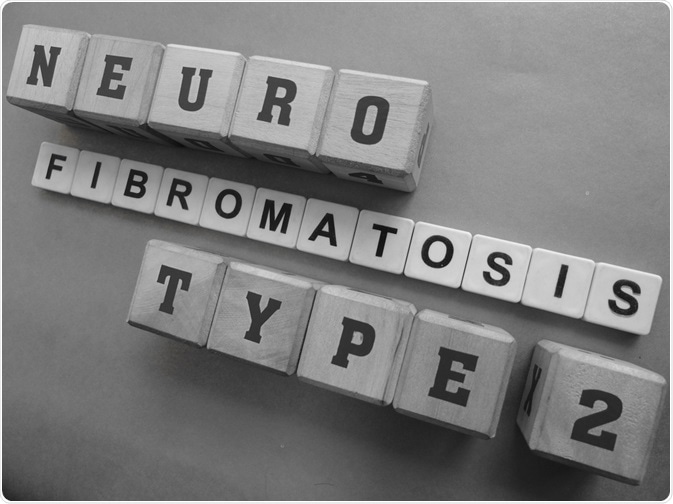Neurofibromatosis type 2 (NF2) is a rare genetic disorder that affects around 1 in 25,000 individuals. In about half of these people, the condition is inherited, while the other half develop a spontaneous mutation and there is no family history of the condition. The mutation that causes NF2 occurs on a single gene located on chromosome 22. A person with NF2 has a 50% chance of passing the illness onto their offspring.

Image Credit: Mamat Suryadi/Shutterstock.com
Symptoms
The condition is unpredictable and variable in its progression and therefore affects people in different ways. People usually start to develop the symptoms and signs of NF2 in late adolescence or their early 20s, although symptoms can develop at any age. The condition is characterized by the growth of benign tumors along nerves in the spine and brain, which leads to a range of neurological symptoms.
Although children with NF2 may present with symptoms, these are often mild and therefore overlooked. The type and severity of symptoms depend on where in the body the benign tumors start to grow but the most common initial symptom is hearing loss or tinnitus (ringing in the ears). Less commonly, the initial symptom is a visual disturbance, seizure, skin tumor, limb weakness, or disrupted balance. In cases of inherited NF2, the severity is often similar between family members, and the type of mutation is therefore considered a major determinant of disease severity.
Some symptoms of NF2 are described below:
Development of schwannomas
The majority of patients with this condition develop benign tumors along the nerves that control hearing and balance. These growths are referred to as vestibular schwannomas (or acoustic neuromas) and can cause hearing loss, tinnitus, and balance problems. Initially, the tumors usually only affect one ear, but by the time a patient reaches the age of 30, tumors have developed in both ears.
Less often, a person with vestibular schwannomas will experience vertigo-like sensations, nausea, and vomiting. As these tumors grow, facial numbness, a weak tongue, and facial pain are more likely to occur.
Cataracts
Around 60% of NF2 sufferers develop cataracts, cloudy areas in the eye lens that can blur vision. This symptom often develops during childhood.
Café-au-lait spots
People with NF2 are at an increased risk of developing light brown pigmentation spots that are a similar color to white coffee. These are referred to as café-au-lait spots.
Peripheral neuropathy
This refers to damaged peripheral nerves and depending on which nerves are involved, symptoms may include pins and needles, numbness, burning sensations, and muscle weakness.
Brain tumors
In around half of the cases, patients develop brain tumors called meningiomas, which can cause vomiting, headaches, convulsions, and visual disturbances.
Spinal cord involvement
About 50% of sufferers develop tumors in the spinal cord referred to as gliomas, which can cause back pain, a “skin crawling” sensation, and muscle weakness.
Assessment of symptoms
As around one-half of people who develop this condition have a spontaneous mutation, there is often no family history of the condition, which complicates diagnosis. To diagnose a person based on their symptoms, at least one of the following needs to apply:
The patient has a first-degree relative with NF2 and also either has unilateral vestibular schwannoma or two of the following:
- Glioma
- Posterior subcapsular lenticular opacities
- Schwannoma
- Neurofibroma
- Meningioma
- Bilateral vestibular schwannomas
Multiple meningiomas in addition to either of the following:
- Any two of schwannoma, cataract, glioma or neurofibroma
- Unilateral vestibular schwannoma
Unilateral vestibular schwannoma in addition to any two of the following:
- Neurofibroma
- Glioma
- Meningioma
- Schwannoma
- Posterior subcapsular lenticular opacities
Assessment of physical symptoms
People who are at an increased risk of developing NF2 should be screened for signs of visual disturbances, hearing loss, and motor or sensory problems. Although meningiomas in the optic nerve are rare, they may be a sign of NF2. Cranial nerve palsies may arise due to tumors forming on the nearby vestibular nerve or due to their direct growth on the cranial nerve.
Differentiating between NF2 and NF1
Differential diagnosis between the rare NF2 and the relatively common NF1 can be difficult. However, patients with NF2 are very unlikely to present with café-au-lait spots, whereas these lesions are common in NF1. Furthermore, the benign growths almost never become cancerous in NF2, whereas their malignant transformation is common in cases of NF1.
Both NF1 and NF2 patients develop subcutaneous lesions but in those with NF2, these are usually defined histologically as schwannomas, while in NF1 patients, they are defined as neurofibromas. Subcutaneous neurofibromas are uncommon in people with NF2.
Finally, subcapsular lenticular opacities are features of NF2, while Lisch nodules would indicate NF1.
References
Further Reading